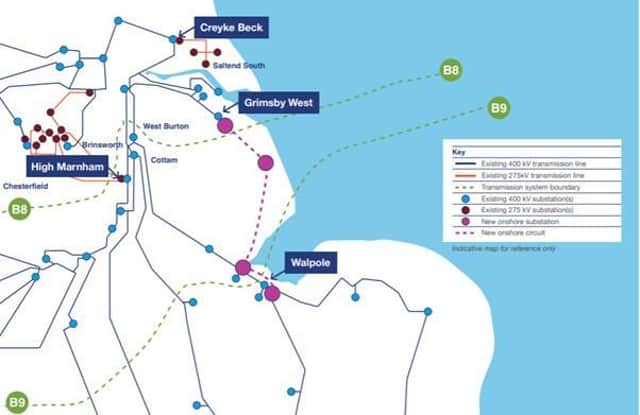Pylon panic in Lincolnshire: Why underground cables are not an option


Residents, council leaders and local MPs have all raised concerns about the impact of the proposed 87-mile electricity network stretching from Grimsby to Walpole in Norfolk. However, National Grid has noted that the preferred underground solution would be roughly six times more costly than overhead pylons.
The ambitious project, billed under The Great Grid Upgrade, is recognised as the most extensive grid overhaul in generations, with the firm asserting its urgent need to connect new green energy sources to the grid.
Advertisement
Hide AdAdvertisement
Hide AdThe current plan involves a new 400,000-volt electricity transmission line, new 400 kV substations at Grimsby West and Walpole, and three additional connection substations, with an estimated cost of around £2.03 billion.


We understand that two of these substations are planned to be situated near the East Lindsey village of Alford on private land.
National Grid has also confirmed that a subsea alternative would cost significantly more, around £9.19 billion, while underground cabling would escalate to about £12.89 billion.
A spokesperson for the company explained: “This new electricity network reinforcement project in Lincolnshire is part of The Great Grid Upgrade and is needed urgently to connect new green energy to the grid.
Advertisement
Hide AdAdvertisement
Hide Ad“This will help meet the Government’s ambition to connect up to 50GW of offshore wind by 2030, so every home and business in Lincolnshire and beyond can be powered by clean, green and more affordable electricity.
“Government and the regulator require us to develop proposals which not only comply with government planning policy and environmental legislation, but are also efficient, economical and represent value for money to consumers, as the cost of new network infrastructure goes onto the energy bills of households across the country.
“We understand that plans for new infrastructure, including pylons, can cause concern in nearby communities, and we will be giving careful consideration to environmental and community impacts, and to feedback we receive from local people and stakeholders through our first consultation process which runs until 13 March 2024.”
Since the announcement of the plans last week, a petition demanding their halt has garnered significant attention, already surpassing 1,000 signatures.
Advertisement
Hide AdAdvertisement
Hide AdTabitha Siddorn, 21, the driving force behind the petition, explained that her family has lived for generations in the small village of Beesby, near Alford, and has worked tirelessly to sustain their small farm amid the quaint setting of this tiny village.
“It’s a very scenic place where we live and to find out that National Grid is wanting to put these huge pylons along the countryside was really disheartening,” she said.
While acknowledging the necessity of future-proofing infrastructure, Ms Siddorn expressed concerns about the potential long-term implications for the region.
She added: “It’s not actually bringing anything to Lincolnshire, it’s power for London. They are going to be destroying wildlife and ruining the future of agriculture.”
Advertisement
Hide AdAdvertisement
Hide AdMs. Siddorn also pointed out that countries like Norway and Sweden have minimal pylons across their countrysides, favouring underground cables instead. She maintained: “If we want to move forward as a country, we need to put these cables underground.”
Piers Pike, 28, one of the petition’s many supporters, added: “This proposal is a typical governmental effort to look like they’re doing something without actually doing anything.
“This compulsory purchase is not only a pure cost-saving scheme but a blatant disrespect and disregard for the people of rural Lincolnshire under the usual guise of ‘progress.'”
He continued: “The reason these pylons are planned to pass through this area is because it’s just outside the Wolds Outstanding Area of Natural Beauty. I can stand in my backyard and see both the Wolds on one side and the sea on the other. It’s criminal.
Advertisement
Hide AdAdvertisement
Hide Ad“It’s disrespectful and the people of Lincolnshire will not stand for it.”
In a Facebook group discussing the proposed pylon plans, Cat Mackinson expressed her dilemma, recognising the necessity for upgraded infrastructure but insisting that there must be a more suitable approach.
“I am undecided,” she said. “I agree that we need to upgrade the infrastructure, but I am just not convinced that this is the best way. I think it’s the cheapest way.
“I can’t see the benefits to locals, our electricity supply is archaic and bad weather brings frequent power cuts – the new lines will benefit the south but what are they doing to improve our supply?
Advertisement
Hide AdAdvertisement
Hide Ad“Are these pylons really the only option? I understand that underground cables are more expensive but are they unaffordable or would it just mean less profits for National Grid?”
Julie Perrot pointed out that if everyone adopted solar panels on their property roofs, there would be no need for these pylons, and the existing grid wouldn’t face overloading issues.
She added: “They’re doing this because the big boys need their profits. It’s not about cost, it’s about control and profit.”